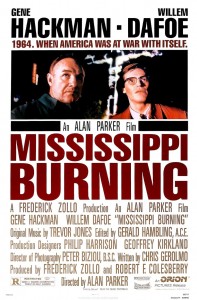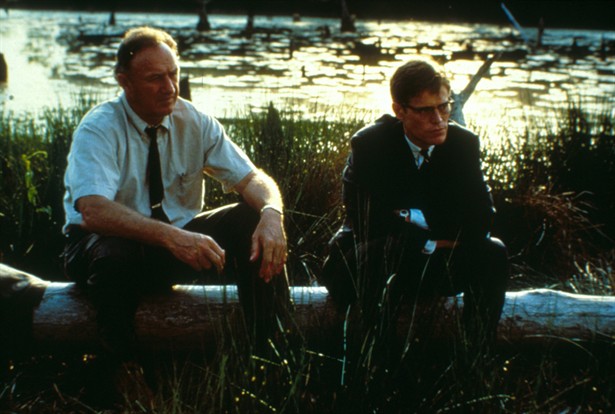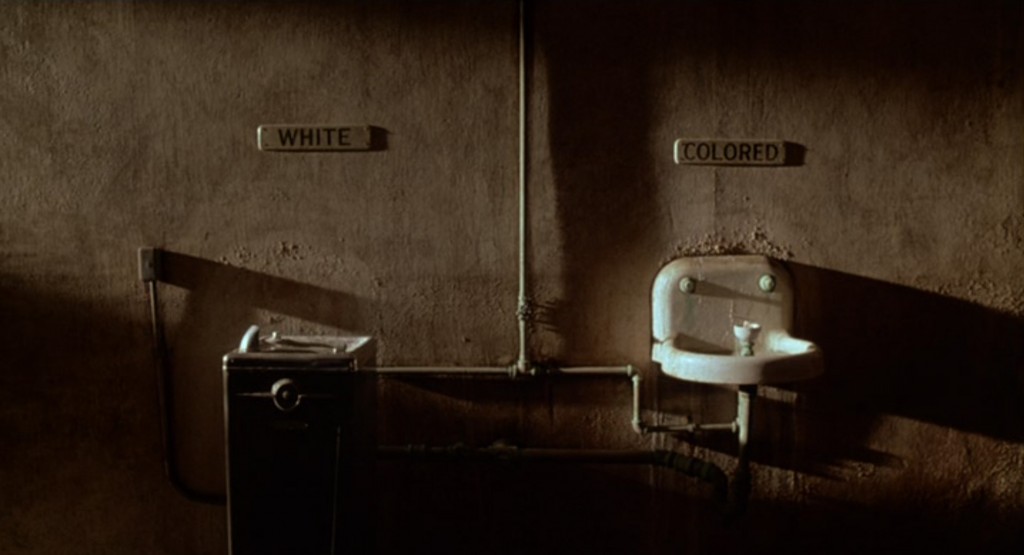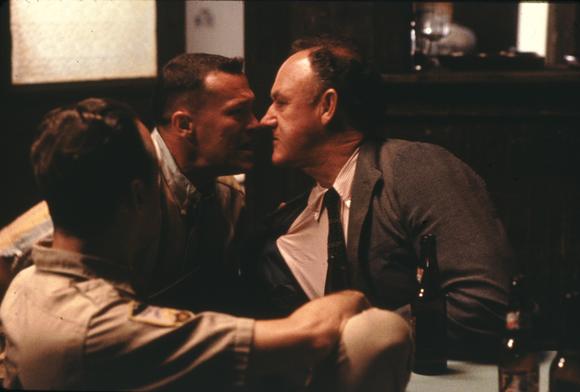 Mississippi Burning (1988)
Mississippi Burning (1988)
Dir: Alan Parker
Stars: Gene Hackman, Willem Dafoe, Frances McDormand, Brad Douriff and Steven Tobolowsky
I grew up in a predominantly white suburban neighborhood in the midwest. I have never had the experience portrayed in the opening scene of Mississippi Burning: a white gent goes to get a drink of water at a public water fountain in a hallway. The water fountain is labeled, “Whites.” A moment later, a little African American boy goes to get a drink of water at the water fountain right next to the “Whites” fountain. That one is labeled, “Colored.”
Immediately following this scene, the credits begin to roll over the images of a small church burning to the ground in the middle of the night, with a somber hymn sung to support the scene. It’s an effective, moving combination of image and sound, as if the production is trying to connect the seemingly peaceful act of two people getting a drink of water at a fountain with the underlying fire in the hearts of the people that posted those signs? I could be off…
The movie concerns the murders of three civil rights activists deep in Mississippi in 1964. The portrayal of the murder is shocking and violent, and sets the stage for the subsequent FBI investigation and related violence that unfolds. We meet Agent Ward (portrayed by Willem Dafoe) and Agent Anderson (played by Gene Hackman) as they drive down the highway to the tiny town in Mississippi where the three activists were last seen. Agent Anderson is going through the bureau’s file on the Ku Klux Klan and finds a little song that they wrote to celebrate their so-called beliefs. As Anderson begins to sing the song for Ward, it’s clear that he’s got a darker sense of humor and ability to see the opposite side’s point of view. Ward, however, is a pure bureau man. Does things by the book. In this scene, Ward makes it clear to Anderson that he’ll insist on being respected despite his youthful disposition. It’s also established that Anderson used to be a sheriff in a little town just like the one they’ll be living in for the foreseeable future. The set pieces for a grand drama are in place within the first 15 minutes: you’ve got an urgent problem that obviously must be solved by the end, you’ve got real villains established (see note 1) and you’ve also got these FBI agents who are coming to the rescue.
The drama unfolds with the same potency as these early scenes. The Klan inflicts horrible atrocities upon the Black community in an effort to ensure no one speaks with the bureau agents and more importantly, no African Americans register to vote. Meanwhile, the bureau fumbles and stumbles as it “goes by the book” and attempts to get hard evidence against those involved in the shooting. The only progress in the investigation stems from Agent Anderson’s interaction with one of the Sherriff’s Deputies’ wives, played by Frances McDormand. The Deputy himself, played with a sinister cool by character actor Brad Dourif (the Doc in Deadwood, anyone?), is like the rest of those involved in the KKK: a stone wall. However, he’s got an airtight alibi with the Mrs., who insists he was with her for a key 50 minutes of time the night of the murder.
I’ll get to some of my favorite scenes, which would be well played in any acting school. For now, I want to comment on a feeling I had in watching the film last week: it was as if there was another layer that I hadn’t noticed before… I kept wondering what that element was that makes this film so good? The “something else” I’m referring to is related to the yin and yang of the two head FBI agents, Mr. Anderson, and Mr. Ward, who only refer to each other with a “Mr.” in front… Personal feelings concerning “the bureau” aside, I consider these two characters to be heroes. However, the fact is that Anderson is frustrated with Ward because he’s so “by the book” he won’t listen to reason. On the flip side, Ward is furious with Anderson because of his “good ol’ boy” sentiments and refusal to follow procedure! Dare I say it, until they agree to start working together, these two “hate” each other. To me, that’s the layer of the film that’s just subtle enough to sends its message over the top: what I mean is, there are hopefully very few of us who can identify with the hate portrayed by the KKK characters in the film, but surely there are many of us who can relate to frustrations with our work associates… or our friends… or those we live with.
 “Let me tell you a story”
“Let me tell you a story”
I think this element of the film, the very idea of storytelling, is a theme I’d overlooked before. Whether it’s the bad guys in the film telling their buddies an off color joke – or worse, a true story of their violent escapades – or the newspapermen trying to gather the elements of their story necessary for an article, or Anderson telling Ward about how his father murdered their “negro” neighbor’s mule, the movie is full of stories.
Think of the great use of interviews that are edited in about midway through the movie. By now, the FBI has hundreds of men in the area and they’ve enlisted the help of the National Guard to search the swamp for the bodies of the missing activists. The news men interview several locals to get their perspective on the whole matter as the National Guard and Agents search in the background. One of the interviewees, a white woman in her 50s with a typical 1960’s styled hair-do, insists that black people aren’t like her, that they’re not hygienic and that “they smell.” This woman didn’t look like a pillar of hygiene herself, by the way…
Regardless, I wondered after I finished the film where in the hell that lady ever heard such a thing? Or was she behind that one African American with B.O. that one time in the grocery years ago? Or worse, was it a story that her best friend told her – that she actually believed? Was it something her parents taught her? These thoughts were naturally provoked, I’m sure by the scene in which Frances McDormand’s character vents to Anderson, saying hate isn’t something you’re born with: it’s something that’s taught and something you marry. While Anderson’s story about his dad is disturbing, I think its theme is clear that sometimes it’s worth questioning that story you heard…
The other scene I want to comment on regarding “let me tell you a story” concerns one of the FBI Agents capturing the Mayor right outside his house and taking him to a tiny shack to interrogate him. This Agent has been recruited to the team by Anderson, only he and Ward had a bit of a “heart to heart,” chat that featured Ward pressing a gun to Anderson’s forehead. No love lost between these two. Regardless, some folks might think the FBI was out of line in this scene, or that their tactics were extreme. I disagree with this thought and would encourage those who think that to go back and watch the scene again: the Agent lays a hand on the Mayor only at the end of the conversation. The only thing that had the Mayor so scared was the guy’s story! Well, that and the props he used…
By now I think you can tell I absolutely adore this movie. I hope this isn’t ruining anything for you (again, I’m somewhat against the whole onus on me of having to label sections with “spoiler alert”), but I’ll end by saying that part of the satisfaction in this film is that justice is actually served. Sure the film is based on a true story (loosely, as all “true stories” are), but I feel like so many of today’s films are willing to end on a very gray note. With this tale, the “arcs” of the characters are complete and justice has been served. Anderson and Ward at least learn to respect each other’s methods and stop hating each other. Those who were responsible for the civil rights activists’ murders are brought to justice, at least for the most part. In other words, we all learned a little something and had a thrilling ride. Do yourself a favor if you haven’t seen this one in a while – or worse, you never saw this one – and bump it into the ol’ Netflix cue!


